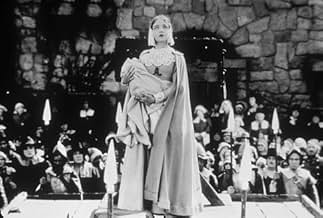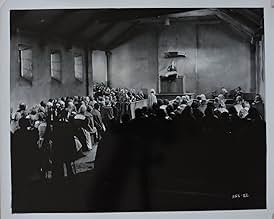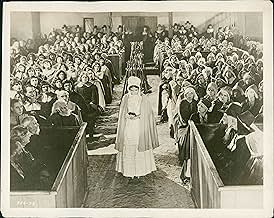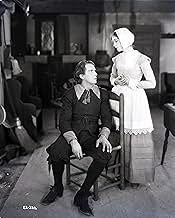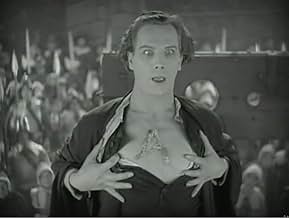AVALIAÇÃO DA IMDb
7,6/10
2,1 mil
SUA AVALIAÇÃO
Adicionar um enredo no seu idiomaAfter having a baby out of wedlock, a young Puritan woman is pressured to reveal the name of her lover.After having a baby out of wedlock, a young Puritan woman is pressured to reveal the name of her lover.After having a baby out of wedlock, a young Puritan woman is pressured to reveal the name of her lover.
- Direção
- Roteiristas
- Artistas
- Prêmios
- 1 vitória no total
Buck Black
- Child in crowd
- (não creditado)
Nora Cecil
- Townswoman
- (não creditado)
Iron Eyes Cody
- Young Indian at Dunking
- (não creditado)
Artye Folz
- Child
- (não creditado)
Dorothy Gray
- Child
- (não creditado)
Douglas Haig
- Minor Role
- (não creditado)
Betsy Ann Hisle
- Child
- (não creditado)
Avaliações em destaque
I'm familiar with concept of the story, but didn't know any of the details of the film, so I was left gripped by it, waiting to see how it would all unfold. Lillian Gish is the lead, and Lars Hanson is the pastor who she has an affair with. Both give great performances on par with their work in The Wind, and the film does a wonderful job at dealing with the complexity of the religious themes. The scene where a bunch of town kids pelt Gish's young daughter with mud simply for being the child of an unwed mother is one of the more harrowing sequences I've seen. It's just brutally grim. Without having read the original source material, I have no idea how accurate the film is, but regardless it was really compelling and complex exploration of religion and hypocrisy.
A young mother is forced to wear THE SCARLET LETTER of adultery by her repressive society.
Nathaniel Hawthorne's classic novel is brought brilliantly to life in this excellent Silent film from MGM. Because the book was on the censored list, Lillian Gish, the era's finest actress, had to campaign vigorously with both the studio hierarchy and civic morality groups around the country to be allowed to make the film, causing her to ironically deal with the same sort of moral strictures her heroine would face in the film.
Her persistence paid off. She was able to obtain the services of director Victor Sjöström and actor Lars Hanson, both from Sweden. Sjöström instructed Miss Gish in the Scandinavian method of natural acting and he gave the film a blunt, no-nonsense look, crisp & clean, utilizing the Studio's excellent sets to the best of their advantage. Frances Marion, the most celebrated screenwriter of the day, was responsible for the literate script.
As the much harried Hester Prynne, Gish is beatific, her face radiating as if from an inner glow. She is playfully sweet as the community seamstress, wanting to cavort on the Sabbath or wear frilly clothing, only two of the actions proscribed & punishable by the Puritans' implacable rigidity. Later, with Hanson, she takes the viewer along as she delights in her new, hidden joy as he returns her love. Whether calmly standing on the scaffold to endure her shame, or fiercely protecting the unbaptized offspring of her forbidden passion, Gish never for an instant loses her grip on the pathetic character she's portraying.
Although he spoke no English, this was not a hindrance to Hanson. Playing the conflicted Rev. Arthur Dimmesdale, Boston's saintly parson, he paints the portrait of a good man literally dying of guilt, a weak man who dare not defend his wife & child. Hanson's face reflects his agony, his left hand twitching at his own breast where his secret symbol of shame is hidden. With Gish unobtainable in this world, he moves steadily towards the inevitable, and deeply poignant, conclusion.
Henry B. Walthall, Miss Lillian's costar in Griffith's THE BIRTH OF A NATION (1915), has the supporting role of a mysterious stranger whose arrival in Boston foreshadows a dire denouement for the wretched lovers.
Also in the cast are Karl Dane who acts out the viewers' dismay at the solemnity of the Puritans, most especially in the person of vindictive gossip Marcelle Corday; there is no love lost between this pair. Movie mavens will recognize diminutive Polly Moran & dour Nora Cecil as rigid Puritan matrons, both uncredited.
Nathaniel Hawthorne's classic novel is brought brilliantly to life in this excellent Silent film from MGM. Because the book was on the censored list, Lillian Gish, the era's finest actress, had to campaign vigorously with both the studio hierarchy and civic morality groups around the country to be allowed to make the film, causing her to ironically deal with the same sort of moral strictures her heroine would face in the film.
Her persistence paid off. She was able to obtain the services of director Victor Sjöström and actor Lars Hanson, both from Sweden. Sjöström instructed Miss Gish in the Scandinavian method of natural acting and he gave the film a blunt, no-nonsense look, crisp & clean, utilizing the Studio's excellent sets to the best of their advantage. Frances Marion, the most celebrated screenwriter of the day, was responsible for the literate script.
As the much harried Hester Prynne, Gish is beatific, her face radiating as if from an inner glow. She is playfully sweet as the community seamstress, wanting to cavort on the Sabbath or wear frilly clothing, only two of the actions proscribed & punishable by the Puritans' implacable rigidity. Later, with Hanson, she takes the viewer along as she delights in her new, hidden joy as he returns her love. Whether calmly standing on the scaffold to endure her shame, or fiercely protecting the unbaptized offspring of her forbidden passion, Gish never for an instant loses her grip on the pathetic character she's portraying.
Although he spoke no English, this was not a hindrance to Hanson. Playing the conflicted Rev. Arthur Dimmesdale, Boston's saintly parson, he paints the portrait of a good man literally dying of guilt, a weak man who dare not defend his wife & child. Hanson's face reflects his agony, his left hand twitching at his own breast where his secret symbol of shame is hidden. With Gish unobtainable in this world, he moves steadily towards the inevitable, and deeply poignant, conclusion.
Henry B. Walthall, Miss Lillian's costar in Griffith's THE BIRTH OF A NATION (1915), has the supporting role of a mysterious stranger whose arrival in Boston foreshadows a dire denouement for the wretched lovers.
Also in the cast are Karl Dane who acts out the viewers' dismay at the solemnity of the Puritans, most especially in the person of vindictive gossip Marcelle Corday; there is no love lost between this pair. Movie mavens will recognize diminutive Polly Moran & dour Nora Cecil as rigid Puritan matrons, both uncredited.
Victor Sjöström's The Scarlet Letter is a masterpiece. It should be put on DVD for all to enjoy, even if parts of the film have to be supplemented with 16mm dupes. TCM hasn't shown it in years, yet they show The Wind several times every year. It makes no sense. The Scarlet Letter is even better than The Wind. It should be shown in high school classes along with the required reading of the classic novel by Nathanial Hawthorne. It makes my head spin to think of how many thousands of children would fall in love with silent film if they were only exposed to this classic. I hate to think of them being exposed to that horrific Demi Moore version instead.
Lillian Gish is radiantly beautiful as the demure but sensual Hester Prynne. Lars Hanson makes an exceptionally wonderful minister Dimmesdale, fighting his romantic feelings for the lovely Hester. Henry B. Walthall makes a very believable and threatening Roger Prynne. Karl Dane adds some wonderful comic relief as Master Giles. The M-G-M production values here are exceptional and the cinematography by Henrik Sartov glows. I love the tracking shots of Hester and the Reverend Arthur Dimmesdale walking together in the woods, and the lovely shot of their reflections in the lake as they confess their love for one another. Poetry on screen. The musical score for the film is quite beautiful, commissioned by TCM in 2000. The only parts that got on my nerves were the harpsichord sections. The flute, piano and violin parts were the best.
Your silent film viewing is not complete without seeing this classic. It's Lillian Gish's best film. Don't miss it.
Lillian Gish is radiantly beautiful as the demure but sensual Hester Prynne. Lars Hanson makes an exceptionally wonderful minister Dimmesdale, fighting his romantic feelings for the lovely Hester. Henry B. Walthall makes a very believable and threatening Roger Prynne. Karl Dane adds some wonderful comic relief as Master Giles. The M-G-M production values here are exceptional and the cinematography by Henrik Sartov glows. I love the tracking shots of Hester and the Reverend Arthur Dimmesdale walking together in the woods, and the lovely shot of their reflections in the lake as they confess their love for one another. Poetry on screen. The musical score for the film is quite beautiful, commissioned by TCM in 2000. The only parts that got on my nerves were the harpsichord sections. The flute, piano and violin parts were the best.
Your silent film viewing is not complete without seeing this classic. It's Lillian Gish's best film. Don't miss it.
I love this film for everything that it is. The story, the acting, the direction, everything about it is great.
The story revolves around Hester Prynne(Lillian Gish) and her love for the Reverrend Arthur Dimmesdale(Lars Hanson). Poor Hester is marked with the 'scarlet letter' when she gives birth to her lovechild with the bishop, and the bishop suffers on his own as his heart begins to fail on account of the guilt he feels.
The orchestration of this film helps a lot because the wonderful music helps you follow the story more and bring intensity. I love Lars Hanson's performance, he has the perfect profile for love scenes.
The story revolves around Hester Prynne(Lillian Gish) and her love for the Reverrend Arthur Dimmesdale(Lars Hanson). Poor Hester is marked with the 'scarlet letter' when she gives birth to her lovechild with the bishop, and the bishop suffers on his own as his heart begins to fail on account of the guilt he feels.
The orchestration of this film helps a lot because the wonderful music helps you follow the story more and bring intensity. I love Lars Hanson's performance, he has the perfect profile for love scenes.
There just aren't enough words to describe the beautiful performances in this film....not that words are needed, then or now. Victor Seastrom's lovingly crafted scenes provide perfect visual frames for the transcendent performances of Lillian Gish and Lars Hanson. An artistic triumph for everyone concerned, and a bittersweet reminder of what was lost with the death of the art of the silent film. (The Turner restoration is alas, also bittersweet, as prints of wildly differing quality had to be "married" in order to create a substantially complete copy of the subject. Thus, viewers move from scenes that shimmer with pristine beauty to muddy, contrasty dupes. It's a tribute to the art of all concerned however, that this is not the distracting issue it might be with a lesser film. Like any work of art, you won't notice the cracks and flaws after a while if you're paying attention as you should. It's just a shame that the entire film isn't as mint-fresh as some of its scenes.)
Você sabia?
- CuriosidadesLillian Gish learned that her mother had had a stroke in London and her sister, Dorothy Gish, urged her to get there on the first available boat. When Lillian informed director Victor Sjöström of the need to finish the film quickly, he created a shooting schedule that crammed two weeks worth of shooting into three days of non-stop work. The crew worked without complaint so that she could finish the film early and catch the earliest possible train to New York.
- Citações
Mistress Hibbins: I am wrongly accused! Never hath my tongue been given to gossip!
The Governor: Falsehood! Her tongue hath wagged like the tail of a dog! Duck her again!
- Versões alternativasIn 2000, Turner Entertainment Co. copyrighted a restored version with a musical score written by Lisa Catarineau and Mark Northam and a running time of 98 minutes. Its previous version ran 79 minutes.
- ConexõesFeatured in The 43rd Annual Academy Awards (1971)
Principais escolhas
Faça login para avaliar e ver a lista de recomendações personalizadas
- How long is The Scarlet Letter?Fornecido pela Alexa
Detalhes
- Data de lançamento
- País de origem
- Central de atendimento oficial
- Idioma
- Também conhecido como
- The Scarlet Letter
- Locações de filme
- Empresa de produção
- Consulte mais créditos da empresa na IMDbPro
Bilheteria
- Orçamento
- US$ 430.290 (estimativa)
- Tempo de duração1 hora 55 minutos
- Mixagem de som
- Proporção
- 1.33 : 1
Contribua para esta página
Sugerir uma alteração ou adicionar conteúdo ausente

Principal brecha
By what name was A Letra Escarlate (1926) officially released in India in English?
Responda
